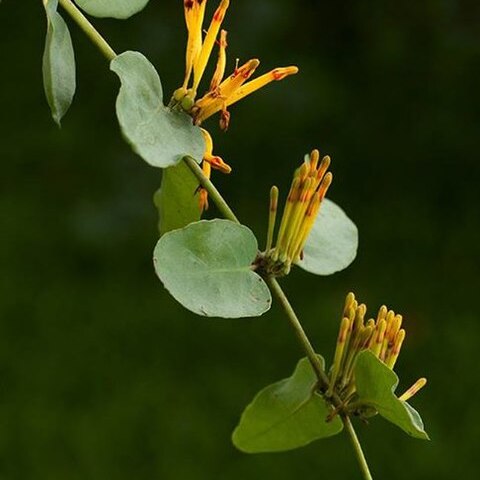Shrubs 1 m or more long, often pendulous with age. Stems rather elongated; young internodes densely, short, brownish-pubescent, brownish glabrate with age, densely lenticellate. Leaves subopposite-alternate, broadly ovate to rounded, 30-50 x 25-35 mm, glabrous, usually glaucous, penninerved, veins raised below, less obvious above; petioles 8-12 mm long, mostly densely and shortly brownish pubescent. Inflorescence: umbels solitary or several in axils, mostly 8-13-flowered, densely crowded; peduncles almost absent or up to 2 mm long, slightly shorter than pedicels, both minutely whitish pubescent. Corolla with conspicuous basal swelling and erect lobes, orange-yellow, greenish yellow basally, 35-40 mm long, tube split 10-12 mm below lobes, whitish pubescent (especially at base). Filaments with small tooth below anthers. Style constricted below stigma. Berries unknown. Flowering in April and May and probably other times also.
Shrubs up to 2 m or perhaps higher, pendulous with age. Stems rather elongated; young internodes short, brownish pubescent, glabrate and brown with age. Leaves opposite-subopposite, mostly falcate-lanceolate, 80-100 x 20-30 mm, thickly coriaceous, penninerved; petioles 10-12 mm long, often shortly brownish pubescent. Inflorescence: umbels solitary, axillary, mostly 8-12-flowered, densely crowded and recurved on pendulous branches; peduncles and pedicels 2-4 mm long, minutely whitish puberulent. Corolla with conspicuous basal swelling, greenish yellow with apical orange band, 35-40 mm long, tube split 8-10 mm below lobes, shortly white-pubescent. Filaments with small tooth below anthers. Style constricted below stigma. Berries unknown. Flowering in November and probably also in other months.
Corolla 3.5–4(4.5) cm long, yellow to yellow-green, banded yellow or orange on lobes with tips green turning dull red outside, pubescent with longer spreading hairs on tube above basal swelling, somewhat glabrescent overall; apical swelling of bud fusiform-conical, sometimes slightly ribbed; basal swelling 3–5 × 3.5–4 mm, ovoid-globular, narrowly constricted above for 2–4 mm; lobes erect, 5–8 mm long, the upper expanded part 3–5 × 0.8–1 mm, linear-lanceolate, hardened inside and thickened proximally, rarely keeled.
Leaves mostly opposite or subopposite; petiole 5–20 mm long; lamina grey-green to markedly blue-green, slightly fleshy, 4–10 × 1–5.5 cm, linear-lanceolate to ovate-elliptic or broadly elliptic, bluntly pointed to rounded at apex, cuneate to rounded or cordate at base, glabrous, with ascending nerves, either pinnate or lower 2–3 pairs more strongly ascending.
Shrub, up to 1 m or more, often pendulous with age, parasitic on other mistletoes including species of Plicosepalus and Viscum. Leaves orbicular, oblong, ovoid, petioles rusty pubescent. Corolla tube swollen at base, corolla lobes erect, corolla whitish pubescent. Filaments red. Flowers orange-yellow, greenish yellow basally.
Rounded shrub extending to 1.5 m, more pendulous with age, flowering on shoots of varying length; branchlets compressed at first, soon terete, densely pubescent with short spreading hairs.
Umbels or heads 8–24-flowered; peduncle and pedicels 2–5 mm long, spreading puberulous; limb of bract 1–1.5 mm long, ovate-triangular, pointed or truncate.
Style red opposite vents, with neck 2–3 mm long; stigma 0.8–1 mm across, capitate.
Stamen filaments red, inflexed; tooth 0.1–0.2 mm long; anthers 2–3 mm long.
Receptacle 1.2–2 mm long, puberulous, sometimes glabrescent.
Calyx 0.2–0.5 mm long, shortly to distinctly toothed.
Berry cherry red, obovoid, pubescent.

